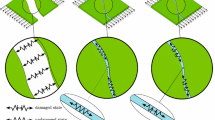Abstract
This paper looks back through the 1960s to the invention of carbon fibres and the theories of Strong Solids. In particular it focuses on the fracture mechanics paradox of strong composites containing weak interfaces. From Griffith theory, it is clear that three parameters must be considered in producing a high strength composite:- minimising defects; maximising the elastic modulus; and raising the fracture energy along the crack path. The interface then introduces two further factors:- elastic modulus mismatch causing crack stopping; and debonding along a brittle interface due to low interface fracture energy. Consequently, an understanding of the fracture energy of a composite interface is needed. Using an interface model based on atomic interaction forces, it is shown that a single layer of contaminant atoms between the matrix and the reinforcement can reduce the interface fracture energy by an order of magnitude, giving a large delamination effect. The paper also looks to a future in which cars will be made largely from composite materials. Radical improvements in automobile design are necessary because the number of cars worldwide is predicted to double. This paper predicts gains in fuel economy by suggesting a new theory of automobile fuel consumption using an adaptation of Coulomb’s friction law. It is demonstrated both by experiment and by theoretical argument that the energy dissipated in standard vehicle tests depends only on weight. Consequently, moving from metal to fibre construction can give a factor 2 improved fuel economy performance, roughly the same as moving from a petrol combustion drive to hydrogen fuel cell propulsion. Using both options together can give a factor 4 improvement, as demonstrated by testing a composite car using the ECE15 protocol.











Similar content being viewed by others
References
Kelly, A.: Strong solids. Clarendon Press, Oxford (1966)
Kelly, A.: Interface effects and the work of fracture of a fibrous composite. Proc. R. Soc. Lond. A319, 95–116 (1970)
Wright, P.: Ferrari formula 1- under the skin of the championship-winning F1-2000. David Bull Publishing, Phoenix Arizona (2004)
Cook, J., Gordon, J.E., Evans, C.C., Marsh, D.M.: A mechanism for the control of crack propagation in all brittle systems. Proc. R. Soc. Lond. A282, 508–520 (1964)
Kendall, K.: Molecular adhesion and its applications. Kluwer, New York (2001)
Shindo, A.: Japan patent application 28287 (1959)
Johnson, W., Philips L.N., Watt, W.: UK Patent 1110791 (1964)
Fitzer, E., Manocha, L.M.: Carbon reinforcements and carbon-carbon composites. Springer Verlag, Berlin (1998)
Beaumont, P.W.R.: Cracking models- broken parts. Appl. Compos. Mater. 13, 265–285 (2006)
Nye, D.: McLaren the Grand Prix, Can-Am and Indy Cars. Hazleton Publishing, p. 222 (1984)
Griffith, A.A.: The phenomena of rupture and flow in solids. Phil. Trans. R. Soc. Lond. A221, 163–195 (1920)
Beckwith, S.W.: Manufacturing defects in composite structures, SAMPE (2012)
Kendall, K.: Control of cracks by interfaces in composites. Proc. R. Soc. Lond. A341, 409–428 (1975)
Kendall, K.: Transition between cohesive and interfacial failure in a laminate. Proc. R. Soc. Lond. A344, 287–302 (1975)
Clegg, W.J., et al.: A simple way to make tough ceramics. Nature 347, 455–457 (1990)
Kendall, K., Dhir, A., Yong, C.W.: Strength by atomic force microscopy: molecular dynamics of water layer squeezing on magnesium oxide. Phil. Mag. 90, 4117–4128 (2010)
Kendall, K.: Inadequacy of Coulomb’s friction law for particle assemblies. Nature 319, 203–205 (1986)
Coulomb, C.A.: Essai sur une application des regles. Mem. Acad. Sci. Savants Etrangers 7, 343–382 (1773)
Casadei, A., Broda, R.: Impact of vehicle weight reduction on fuel economy for various vehicle architectures, Research report for Aluminium Association, Ricardo Inc (2007)
Pagerit, S., Sharer, P., Rousseau, A.: Fuel economy sensitivity to vehicle mass for advanced vehicle power trains, SAE world Congress and Exhibition, Paper 2006-01-0665 (2006)
Staffell, I., Kendall, K.: Lower carbon cars by reducing dissipation in hydrogen hybrids. Int. J. Low Carbon Technol. 7, 10–15 (2012)
Kendall, K., Pollet, B.G., Dhir, A., Staffell, I., Millington, B., Jostins, J.: Hydrogen hybrid fuel cell vehicles for Birmingham campus. J. Power Sources 196, 325–330 (2011)
Shang, J.L.: The role of hydrogen and fuel cell for ultralow carbon vehicles, PhD thesis, University of Birmingham (2012)
SWARM project, www.cordis.eu
Acknowledgements
Thanks are due to John Jostins of Microcab Ltd who built the original car in 2005, Hugo Spowers of Riversimple Ltd and Bruno Pollet of Western Cape University for useful discussions
Author information
Authors and Affiliations
Corresponding author
Additional information
Paper delivered at DFC12, Queens College, Cambridge, 9th April 2013
Rights and permissions
About this article
Cite this article
Staffell, I., Shang, J.L. & Kendall, K. Atomic Models of Strong Solids Interfaces Viewed as Composite Structures. Appl Compos Mater 21, 45–55 (2014). https://doi.org/10.1007/s10443-013-9330-y
Received:
Accepted:
Published:
Issue Date:
DOI: https://doi.org/10.1007/s10443-013-9330-y




